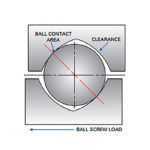Direct drives are a motion-control technology projected to see high rates of adoption in coming years, according to market research by the ARC Advisory Group. That’s due in part to an array of industries driving for higher throughput and more accurate processes.
According to Brian Scott, applications engineer at Nippon Pulse America Inc., linear shaft motors excel industrial manufacturing machines and high-accuracy and high-resolution metrology applications.
“We see from sales and applications that there’s significant effort now to move from rotary movement mechanics to direct-drive linear. High-force-density tubular linear motors are one option here. Simpler mechanics and the desire to reduce components are main market forces; others include better linear control and response, fewer failure modes, and reduced supplier counts. As the industry moves forward, there will be increasing conversion to direct-drive linear motion.”

Battery-powered designs also benefit from direct drives on linear axes. For such systems, Steven Feketa of LinMot USA Inc. predicts that direct-drive motors will continue to evolve to become smaller and more compact — with power characteristics suitable for use in mobile designs. These have often been the domain of fluid-powered systems — but Feketa underscores that electric systems are often less wasteful and better performing.

“We’ve been involved with direct-drive rotary and linear positioners for more than 30 years and have seen them transition from being a novel drive technology to something that’s ubiquitous in positioning applications,” said Brian O’Connor, director of product and market development at Aerotech Inc. So it’s common now to see direct-drive designs in high-precision applications such as semiconductor and consumer electronics — and even in lower-precision applications such as labeling and product packaging assembly lines, added O’Connor.

Application-specific design features from linear direct drives
In some cases, direct-drive options for linear applications can allow for more complete customization to specific applications. Consider how some IP69K linear motors are all laser welded to eliminate seals and entry points — to get long design life. “Another example is LinMot’s PR02 linear-rotary actuators, which deliver two motion types (to simplify integration) and have integrated load cells for precise torque measurements on capping and threading applications,” added Feketa.

Coordinated engineering efforts with the supply chain and design-engineering teams produce such application-specific products, added Feketa. “Another example is the shortening of PR02 series linear-rotary actuators — which we did to make them fit under fume hoods in pharmaceutical applications.”
Tubular linear-rotary motors from LinMot also find use on axes of automated-warehouse equipment — including diverter, reject, and handling axes. Within pick-and-place and position systems for packaging and automated assembly, the actuators work in X-Y, X-Y-theta, X-Y-Z, X-Y-Z-theta, and X-X’-Y-Z setups. On collaborative robots, the linear-rotary motors actuate end effectors and other light-load axes.
Bending linear-motion definitions with curved direct drives
Curved variations of linear motors are a newer direct-drive variation. “These work best in applications that only need semi-circular motion … or on axes with large diameters … and not needing all the torque that a large motor would provide,” said Brian Zlotorzycki, product specialist at ETEL Motors. “So here, the benefits of direct-drive motors can serve unorthodox configurations with smaller overall footprints that necessitate simpler installation and fewer repairs.”
In the medical field, curved linear motor tracks already find use on C-Arm and CT scanning machines where a torque motor would be too unintuitive.








Leave a Reply
You must be logged in to post a comment.